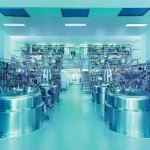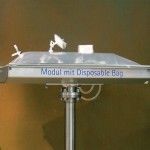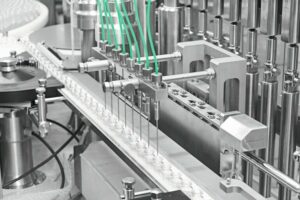Stainless steel fermenters have proven themselves in biotechnology for many years. They are upgradable at any time and can thus improve production processes sustainably and creatively. Disposable bioreactors yield fast results. Do they represent the future or do they simply reflect the anachronistic throw-away society?
Dr. Karin Koller
A heated discussion is currently taking place about whether plastic disposable bioreactors have the potential to replace well-proven, stainless steel fermenters. Disposable reactors require much lower capital costs than steel fermenters. Since no extensive piping is needed, the installation time is significantly shorter. SIP and CIP processes are rendered unnecessary, reducing chemical, water and energy consumption and facilitating validation. The process seems to be much less complicated. On the downside are the increased operational costs, the high output of waste in the form of plastic bags, possible leaching of extractables and the limited possibilities for process control. Superficially viewed, the advantages seem to prevail. However, if we consider recent developments in biotechnology, it is no longer clear whether a reduction in complexity really is advisable.
Creativity through modularity
Biotechnological development should naturally ensure the highest possible yields with the lowest possible expenditure of time, money and working hours. One approach is to enhance product formation rates by creating optimum conditions for bacterial or cell cultures. This can be achieved by means of feedback control, the addition of inducers or controlled process management.
Another possible strategy is to utilise more productive organisms. Extremophile and marine microorganisms have given rise to promising results, from the production of enzymes for detergents to the development of drug delivery systems. Genetically manipulated bacteria generate high product yields either directly or in the form of inclusion bodies, which provide very pure products after refolding. If correct glycosylation of the proteins is required, genetically modified yeast can be a more productive alternative to cell culture. A third approach is biotransformation for the production of high-value molecules and bulk products that could previously only be manufactured in an expensive, multi-step chemical synthesis.
Each of these approaches requires precisely defined culture conditions as well as, to create them, special equipment and control systems. A stainless steel reactor for biotechnological research is designed to suit the requirements of the processes developed in the laboratory. It should then operate for many years. At the time the reactor is purchased, the developments in biotechnological process management and the buyer’s own product portfolio are often unforeseeable. The risk that the equipment will be outdated a few years after its acquisition and that the planned process can no longer be conducted in the bioreactor cannot be ruled out.
To eliminate this problem, all Bioengineering bioreactors – from laboratory to production scale – are of modular design. This means that every newly developed component is designed as a module and can be seamlessly installed in established bioreactors. Examples of such modules include the rotor filter for the perfusion of cell cultures, the fixed bed insert for adherent cells or the methanol control system for protein expression in methylotrophic yeasts. For refolding inclusion bodies or cultivating marine microorganisms, all steel components in Bioengineering glass fermenters can be replaced with the high-performance PEEK thermoplastic.
Just like the components, Bioengineering’s BioScada software is also designed as a series of modules. From simple process visualisation to complete automation of the fermentation plant, the software can be progressively expanded and upgraded.
Hardware and software modularity in stainless steel fermenters enables flexible adjustment of the equipment to the process requirements. It leaves plenty of scope for creativity and can thus lift the process to new levels. By contrast, not only are agitation, aeration and control systems in disposable bioreactors very limited, there is also no means of integrating components to enhance productivity.
Complex production
After it has been developed in the laboratory, the process must be transferred to production scale. Once again, the disposable bioreactor soon comes up against limitations. Upscaling data for steel bioreactors, such as hydrodynamic characteristics, has been collected over a period of several decades. Owing to the identical geometries, scaled components and homogeneous software, the process can be migrated from laboratory to production scale without any problems or delays. Upscaling with disposable fermenters is often problematic due to the inadequate mass and heat transfer. The lack of measurement and control systems can render the process uncontrollable. Upscaling frequently fails because the bags are not produced in the desired size.
It is true to say that disposable bioreactors make processes less complicated. At the same time, it must be remembered that they also operate with very simplified process technology. Automated steel bioreactors possess highly developed, complex control technology for data analysis, feedback control and individual process management. In combination with components specially selected or even custom-made for the process, maximum product yields can be achieved. A high degree of automation decreases labour input and eliminates fail-ures caused by human errors.
Every process step is defined in a software operation and can be started after preparing the reactor at the push of a button. The software then controls the process, monitors all relevant parameters, alerts the operator in the event of any non-conformances and seamlessly documents the process including all manipulations, process values and alarms. A mature system with a well though-out automation concept considerably simplifies highly complex and precisely defined processes, even on an industrial scale. Neither the complexity of the process technology nor the functionality of the components are compromised.
Efficiency through sustainability
The need for sterilisation, CIP and valid-ation remains a disadvantage compared to disposable bioreactors. The consumption of resources and the residual risk of cross-contaminations in multipurpose plants are the main arguments against steel fermenters.
CIP systems are usually fully automated. The CIP process is thus activated with minimum labour costs at the push of a button. Chemical consumption is minimised by recycling. The circulated cleaning so- lutions are monitored for impurities and automatically replaced according to the specification. This not only lowers consumption but also eliminates sampling and cuts down the time for preparation. Rinse times and water consumption are likewise reduced to a minimum with sophisticated components such as the rotating RotaCIP lance.
Fully automated, efficient cleaning on a laboratory scale is also the status quo at Bioengineering. CIP mobile, the mobile, automated CIP system, is connected to the bioreactor and the utilities in a few simple steps and stored in a space saving way after cleaning. Sterilisation is automated and fully documented in all in situ sterilisable reactors. The medium is usually sterilised together with the vessel. This reduces the need for subsequent intervention in the sterile system and minimises the contamination risk. In disposable fermenters the bag is already presterilised. The medium, however, has to be filled into the bag in a sterile way. Problems can occur if the sterile filtration unit is clogged or if microbial contaminations are introduced due to filter defects or incorrect hose connections.
CIP and SIP necessitate additional valid-ation steps. Validation, however, is not only effort, but also unambiguous confirmation that the process can be conducted in compliance with the applicable regulations. Through validation, the manufacturer documents that the process takes place in a cleaned and sterile reactor. Owing to the interaction of the software, not only cleaning and sterilisation are seamlessly documented but also the entire process. Forgery-proof documentation of all manipulations during the process, including the user name and time signature, provides a record of correct production.
Online-Info www.cpp-net.com/2110467
Share:








